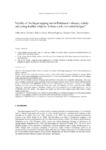Mostrar o rexistro simple do ítem
Validity of the finger tapping test in Parkinson’s disease, elderly and young healthy subjects: is there a role for central fatigue?
| dc.contributor.author | Arias, Pablo | |
| dc.contributor.author | Robles-García, Verónica | |
| dc.contributor.author | Espinosa, Nelson | |
| dc.contributor.author | Corral Bergantiños, Yoanna | |
| dc.contributor.author | Cudeiro, Javier | |
| dc.date.accessioned | 2015-04-27T08:38:39Z | |
| dc.date.available | 2015-04-27T08:38:39Z | |
| dc.date.issued | 2012-05-03 | |
| dc.identifier.citation | Arias P, Robles-García V, Espinosa N, Corral Y, Cudeiro J. Validity of the finger tapping test in Parkinson’s disease, elderly and young healthy subjects: is there a role for central fatigue?. Clin Neurophysiol. 2012;123:2034-41 | es_ES |
| dc.identifier.uri | http://hdl.handle.net/2183/14450 | |
| dc.description.abstract | [Abstract] Objective: The main goal of this work is to evaluate the validity of the finger tapping test (FT) to detect alterations in rhythm formation. Methods: We use FT to study the alterations in motor rhythm in three different groups: Parkinson’s patients, elderly healthy controls, and young healthy control subjects (HY). The test was performed in COMFORT and FAST tapping modes and repeated on two different days. Results: For the variables analyzed (frequency and variability) both modes were repeatable in all groups. Also, intra-class correlation coefficients showed excellent levels of consistency between days. The test clearly differentiated the groups in both FAST and COMFORT modes. However, when fatigue was analyzed, a decrease in the tapping frequency was observed in HY during the FAST mode only. The amplitude of motor evoked potentials (MEPs) induced by transcranial magnetic stimulation (TMS) was early-potentiated but not delayed-depressed, both for COMFORT and FAST modes. This suggests that fatigue was not of cortico-spinal origin. Other forms of central fatigue are discussed. Conclusions: FT at FAST mode is not a valid test to detect differences in rhythm formation across the groups studied; fatigue is a confounding variable in some groups if the test is performed as fast as possible. Significance: COMFORT mode is recommended in protocols including the FT for evaluating rhythm formation. | es_ES |
| dc.description.sponsorship | This work was supported by Xunta de Galicia (Conselleria de Educación-2007/000140-0 and Dirección Xeral de I+D+i; 2010–2012), Spain. We are indebted to Dr. Kenneth L. Grieve for his helpful advice and corrections in the manuscript. All authors declare no competing interests exist. | |
| dc.description.sponsorship | Xunta de Galicia; 2007/000140-0 | |
| dc.language.iso | eng | es_ES |
| dc.publisher | Elsevier | es_ES |
| dc.relation.uri | http://dx.doi.org/10.1016/j.clinph.2012.04.001 | es_ES |
| dc.rights | This is the author’s version of a work that was accepted for publication in "Clinical Neurophysiology". Changes resulting from the publishing process, such as peer review, editing, corrections, structural formatting, and other quality control mechanisms may not be reflected in this document. Changes may have been made to this work since it was submitted for publication. | es_ES |
| dc.subject | Finger tapping | es_ES |
| dc.subject | Parkinson | es_ES |
| dc.subject | Fatigue | es_ES |
| dc.subject | Validity | es_ES |
| dc.title | Validity of the finger tapping test in Parkinson’s disease, elderly and young healthy subjects: is there a role for central fatigue? | es_ES |
| dc.type | info:eu-repo/semantics/article | es_ES |
| dc.rights.access | info:eu-repo/semantics/openAccess | es_ES |
Ficheiros no ítem
Este ítem aparece na(s) seguinte(s) colección(s)
-
GI-NEURO - Artigos [140]
-
INIBIC-NEURO - Artigos [48]






